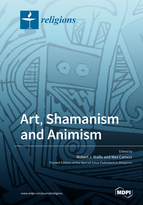Art, Shamanism and Animism
A special issue of Religions (ISSN 2077-1444). This special issue belongs to the section "Religions and Humanities/Philosophies".
Deadline for manuscript submissions: closed (15 February 2021) | Viewed by 52313
Special Issue Editors
Interests: art; archaeology; anthropology; shamanism; neo-shamanism; animism; rock art; prehistory; human–animal relations; pagan studies; early medieval art; Vikings
2. Anthropology Department, Goldsmiths College, University of London, London SE14 6NW, UK
Interests: anthropology of art; native American expressive cultures; material culture; ethnographic museums and collections; indigenous cosmologies; belief; animism; shamanism
Special Issue Information
Dear Colleagues,
We are writing to invite you to contribute to the Special Issue of Religions journal with the theme ‘Art, Shamanism and Animism’. The scope concerns the art, materiality and representation of shamanism and animism, from prehistory to the present and on a global scale.
Recent scholarship in anthropology, archaeology and the study of religion has theorised the roles of shamans within wider-than-human animist communities in terms of relational ontologies and other indigenous ways of knowing. The importance of visuality and materiality in shamanic and animist ritual performance is less well studied. This thinking has also permeated into contemporary art practice, museum representations and other forums of display.
Papers are invited from across disciplines which consider the art, materiality and/or representation of shamanism and animism in any period or region. Recent thinking has examined how these themes can be approached without recourse to a culture–nature dichotomy, in the light of the inter-disciplinary ontological turn and other post-humanist thinking in the humanities and social sciences.
This Special Issue engages critically with established thinking and tackles the next step, where the thinking on and practices of art, shamanism and animism go from here. Papers that theorise the relationships between the concepts of art, shamanism and animism in innovative ways are particularly welcome.
Dr. Robert J. Wallis
Dr. Max Carocci
Guest Editors
Manuscript Submission Information
Manuscripts should be submitted online at www.mdpi.com by registering and logging in to this website. Once you are registered, click here to go to the submission form. Manuscripts can be submitted until the deadline. All submissions that pass pre-check are peer-reviewed. Accepted papers will be published continuously in the journal (as soon as accepted) and will be listed together on the special issue website. Research articles, review articles as well as short communications are invited. For planned papers, a title and short abstract (about 100 words) can be sent to the Editorial Office for announcement on this website.
Submitted manuscripts should not have been published previously, nor be under consideration for publication elsewhere (except conference proceedings papers). All manuscripts are thoroughly refereed through a double-blind peer-review process. A guide for authors and other relevant information for submission of manuscripts is available on the Instructions for Authors page. Religions is an international peer-reviewed open access monthly journal published by MDPI.
Please visit the Instructions for Authors page before submitting a manuscript. The Article Processing Charge (APC) for publication in this open access journal is 1800 CHF (Swiss Francs). Submitted papers should be well formatted and use good English. Authors may use MDPI's English editing service prior to publication or during author revisions.
Keywords
- art
- shamanism
- animism
- relationality
- ontologies
- post-humanism
- visual culture
- material culture
- representation
- ritual performance






